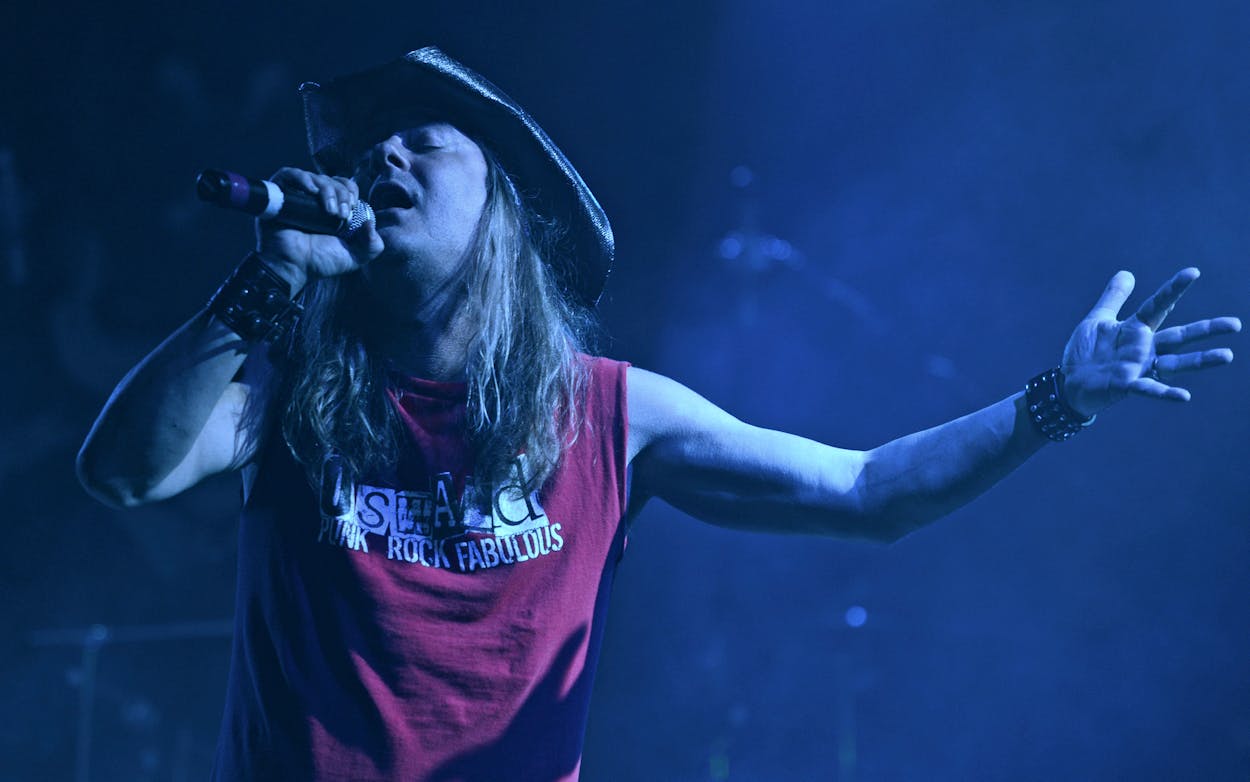If rock and roll had a face, it would have been Johnny Solinger’s. From the moment he emerged on the Dallas metal scene in the early nineties, through his long stint as the front man of Skid Row, Solinger looked and sounded like rock personified. He was like the creation of an artificial intelligence fed nothing but cheap beer, Mötley Crüe records, and episodes of MTV’s Headbangers Ball.
Until Solinger’s death on June 26 at the age of 55, he even seemed kind of immortal, so blissfully untouched was he by time. In the photos he posted to his Facebook page, Solinger—his long, blond tresses spilling out of snakeskin cowboy hats—seemed happily frozen in a wilder era.
Maybe he was. In the 1991 footage of his eponymous group, Solinger, that you can find on YouTube, he looks almost exactly, eerily the same. There’s Johnny, already rocking a bandana and sleeveless tee, whipping his golden locks while he volleys between shouts at the devil and operatic yowls. With hindsight, maybe the modern viewer can sense the specter of Nirvana, lurking around the edges of the VHS grain, ready to hasten the demise of hair metal that same year. But you’d never know it from watching Solinger belt out tunes like “Hot, Fast, and Hard and Looking for Love.” He sings and moves like he’s destined to do this forever.
It’s easy to surmise what Skid Row saw in Solinger, when the band invited him to a 2000 audition to be its new lead singer. Skid Row had been through a lot by then, surviving not only the grunge years but a nasty public split with its charismatic front man, Sebastian Bach. Solinger didn’t just have the hair or the high notes. He had the exact swagger Skid Row needed in order to pick itself back up. “We were halfway through the second song and we knew he was the guy,” bassist Rachel Bolan would later tell the Dallas Observer.
Solinger would remain “the guy” for the next fifteen years—the longest-running front man in Skid Row history. He recorded two albums and two EPs with the band, performing in front of thousands of fans all over the world alongside groups like Aerosmith, Kiss, and Bon Jovi. Yet throughout it all, Solinger had to contend with Bach’s shadow—from critics, from “purists,” and even from Bach himself, who couldn’t help taking potshots at his old frenemies. Solinger may have been “the guy,” but to many he would forever be “the new guy.”
Somehow, Solinger always remained upbeat about all of this. In interviews he shrugged off constant questions about Bach and the “classic” lineup, remaining forever excited about his own future with Skid Row. But that ended in 2015 when the band suddenly fired Solinger over the phone, mere hours before announcing former TNT singer Tony Harnell as his replacement. Solinger tried to stay positive about that too, releasing a statement saying he’d decided to pursue a solo career and wishing Skid Row luck. His former bandmates disputed this just days later, with Bolan noting in a radio interview that, while the split was amicable, they simply didn’t feel like he was cutting it anymore.
Solinger may have seemed untouched by time, but you could argue that he struggled against it. His career was ascendent right as the music he loved was falling rapidly out of fashion. In 1996, the Dallas Observer sneered that he and his band were already “fossils encased in Spandex and leather, cliches tangled in long hair and power ballads.” When Solinger joined Skid Row, it was long after the group’s own Spandexed heyday. He spent more than a decade trying, somewhat futilely, to compete with its past, only to see the band dump him amid another midlife crisis. There is the sense that had Solinger only hit his stride a bit earlier, he might have avoided all of this and become a huge star in his own right, rather than being forever tied to a band that, in the end, was never really his.
Yet to Solinger’s credit, none of this seems to have bothered him. After Skid Row, he retreated to his home in Conroe, where he passed the time fishing and doing volunteer work on behalf of veterans and animal rescue. He kept up with music, performing the occasional solo show of Skid Row material and joining the Las Vegas revue Raiding the Rock Vault, where he covered classic hits alongside alumni of bands like Dio, Whitesnake, and Quiet Riot. He even began pursuing a career in country, releasing the EP Scrappy Smith shortly before leaving Skid Row, then following it with a twangy take on “Santa Claus Is Coming to Town” and his Tanya Tucker–inspired version of Ed Bruce’s “Texas (When I Die).”
In May, Solinger revealed on Facebook that he’d been diagnosed with liver failure, saying that “as with most musicians I do not have health insurance and it’s very difficult to get proper care without it.” A friend, Brian Lawrence, launched a GoFundMe campaign to help pay for Solinger’s medical bills. It eventually raised $16,525 of its $100,000 goal. But again, it seems, time worked against Solinger. He died on June 27. The campaign has since switched to raising funds for his funeral.
It’s tempting to characterize Solinger’s story as tragic, to suggest that he never really got his fair shake—from Skid Row fans, who refused to let go of the past; from a music genre that struggled to adapt to the future; and certainly from the American health-care system. That’s probably not how he would see it, though. By all appearances, Johnny Solinger was just grateful for the ride and determined to keep the party going. He was rock and roll in that way, too.
- More About:
- Music
- Obituaries






